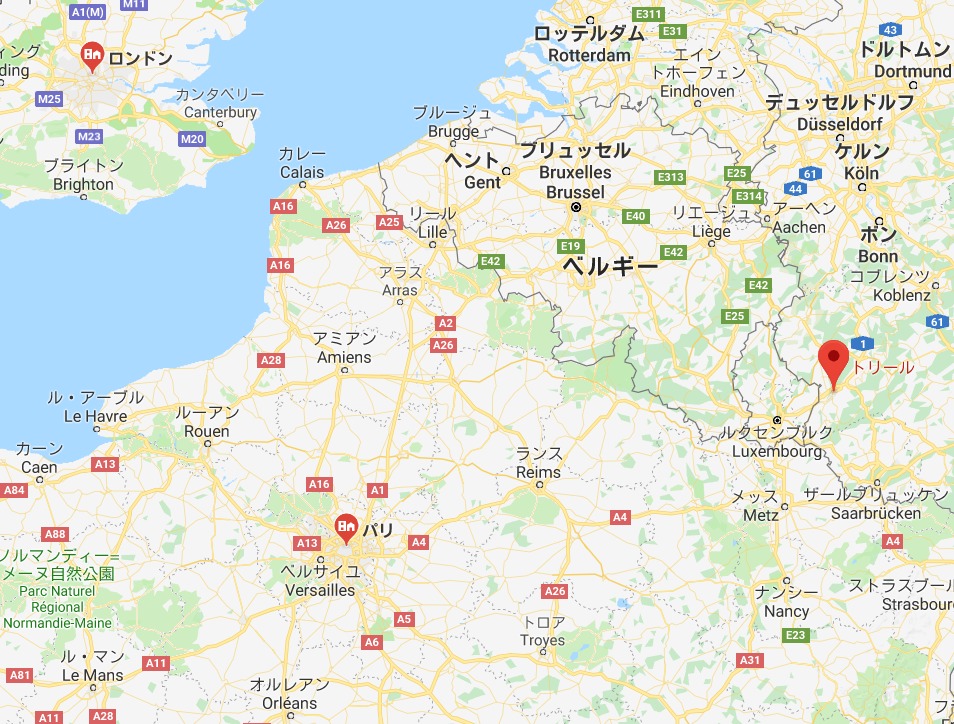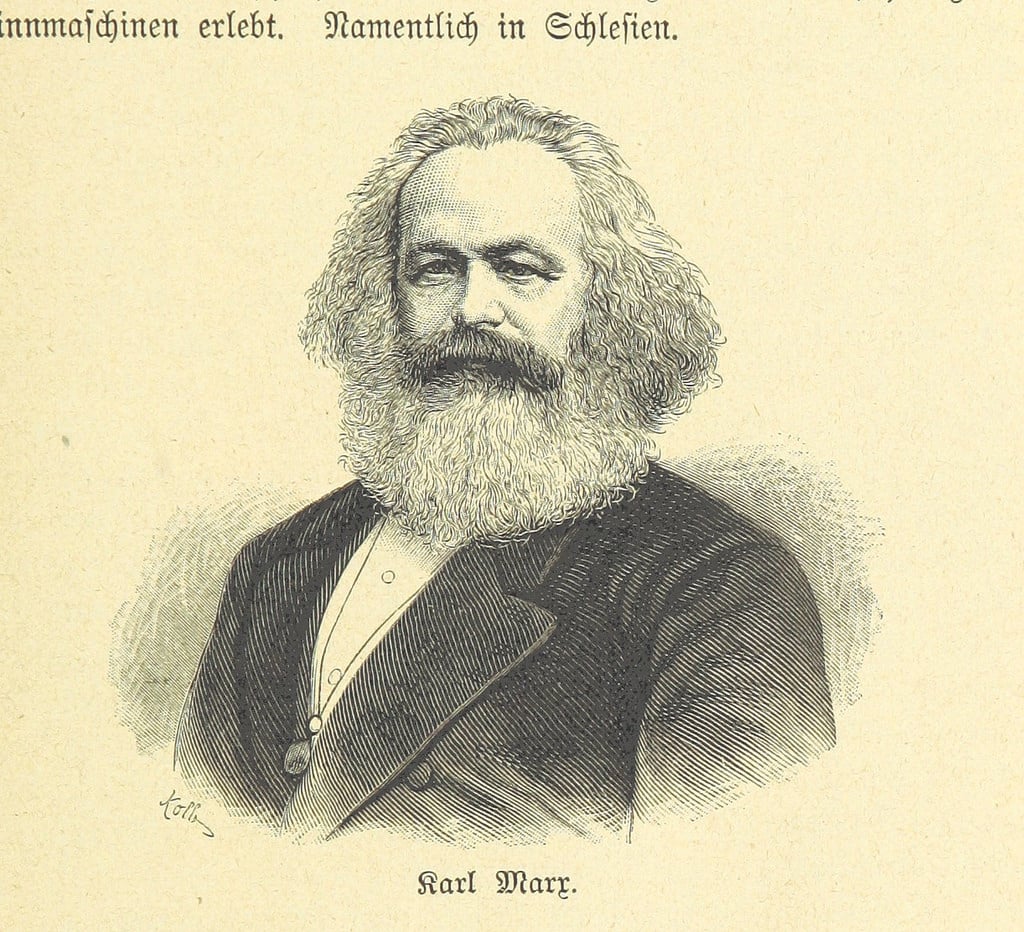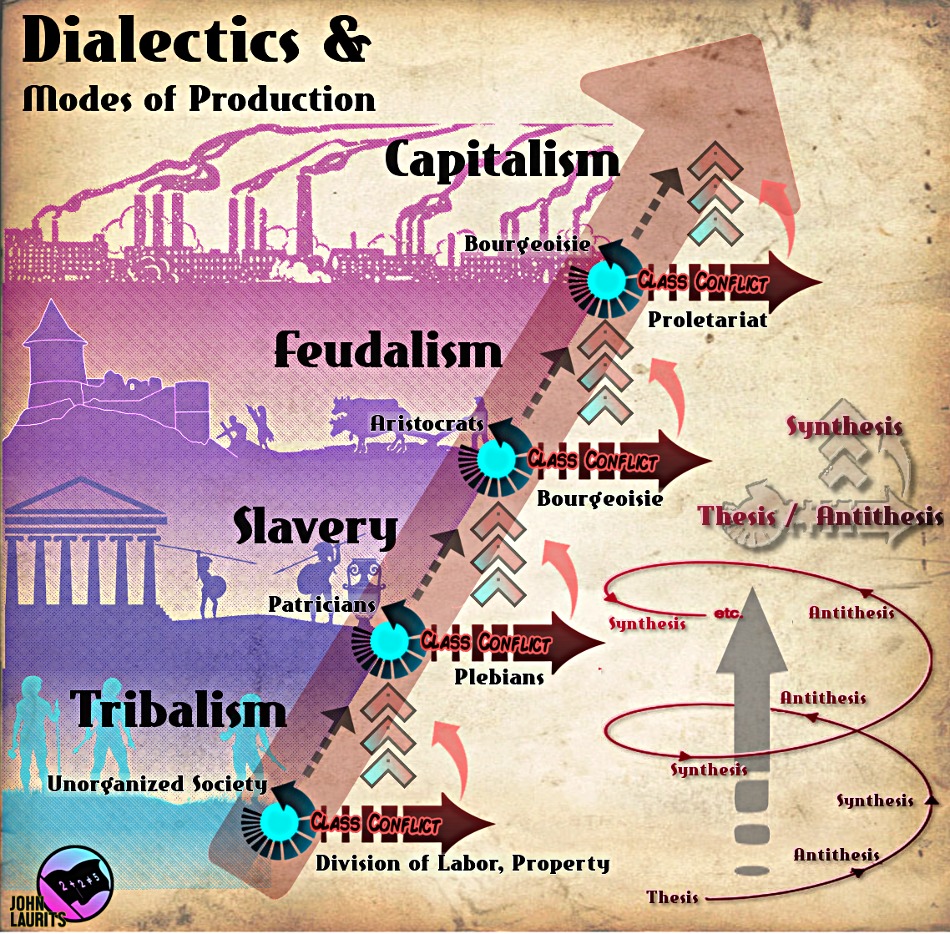昨年は地味にマルクス生誕200年でした。現代ではマルクス経済学(マル経)は終わった学問扱いになっているようですが、マルクスの思想そのものは名前を変えて薄く広く現代にも影響を与えています。最近流行りのネオリベラリズム(文化相対主義、ダイバーシティ、ジェンダーフリー、夫婦別姓、アイデンティティ・ポリティクス、ポリティカル・コレクトネス等々)は、「神抜き」で世界を説明するマルクス的唯物論が自由主義に浸透した結果生まれた、と考えられないこともないです。
ヨーロッパ最古の都市トリーアに生まれた革新思想家
下の地図をご覧ください。マルクスの生まれ故郷はトリーア(Trier、Googleマップ内のトリールはむかしの呼び名。フランス語表記ではTrèves)。トリーアはローマ帝国がヨーロッパ大陸進出の拠点として紀元前1世紀に建設したヨーロッパ最古といわれる古都です。
建設時の名称はアウグスタ・トレヴェロールム(Augusta Treverorum)。ベルギー原住民のトレベリ族(Treveri)の地をアウグスティヌスが征服して建設した都市という意味になります。隣接するルクセンブルクも同じく、元はトレベリ族が住んでいた土地だったそうです。
トリーアに残るローマ遺跡については以下のサイトが参考になります。
ローマ人はローマ風の建築や水道技術とともに、さまざまなローマ文化をもたらしました。そのひとつが赤ワイン醸造技術だったのですが、土地が赤ワイン品種の栽培に適しませんでした。そのため独自に白ワイン品種(リースリング)を作り出したトリーアはモーゼルワイン(Model Wine)の発祥地として知られています。
そんな古い土地柄に住んでいた改宗ユダヤ人の家庭に20世紀随一の革新思想家が生まれたのです。京都でハイテク企業京セラが生まれたようなものでしょうか。

地図を見るとわかるように、トリーアはフランスのアルザス=ロレーヌ地域と国境を接し、仏独両国の相互影響が強い地域です。
マルクスのトライアングル
フランス革命の余韻冷めやらぬ時代の空気で育った若きマルクスはパリへ出ます。そこで盟友エンゲルスに出会うのですが、お互い別々にほぼ同じことを考えていたというのは面白いですね。
マルクスらの思想運動は当局に目をつけられ、政治的要注意人物として国外追放されてしまいます。マルクスは比較的政治的縛りの緩かったロンドンへ逃れ、家族(奥さんは貴族出身)とともに残りの生涯を過ごすことになりました。30年以上も定職を持たず極貧に甘んじながら研究を続け、主著『資本論』を書き続けます。
マルクスはトリーア=パリ=ロンドンという比較的狭いトライアングルの内部を生息圏として未来社会を構想したわけですが、これは象徴的な三角形といえます。政教分離の視点から比較してみましょう。
- トリーアは政教分離に反動的な動きをしていたプロイセン王国に属していました。プロイセンは18世紀末頃からユダヤ人にキリスト教徒と同等の市民権と義務を与えようとする動きが活発でした。しかしマルクスが生まれた時代の王ヴィルヘルム4世は反動的政策を打ち出し、ユダヤ人から市民権を取り上げようと画策しました。プロイセンがプロテスタントを国教化したためです(改宗しないユダヤ人は異教徒認定)。この国教化は聖書のイエスが説いていた「カエサルのものはカエサルへ」の政教分離原則に背く選択でした。
- とはいえトリーア近辺はフランスとの国境地域で文化的にも独仏のせめぎあう土地柄です。しかもローマ時代の古都ですから、いわゆるゲルマン系バリバリの土地柄ではありません。そうした風土が青年マルクスを左派思想家に近づけたのかもしれません。
- パリは元来カトリック教国家であるがゆえ政教分離を暴力(王の虐殺)でしか成し遂げられなかった急進革命の地です。言語的にもプロイセンとは異質なラテン系言語の世界です。
- ロンドンは自由主義の揺籃の地であり、大陸より穏やかな政教分離を模索していたイングランドに属していました。イングランドは保革のバランス感覚の発達した土地で、当時、政教分離原則をすでに確立していたアメリカの政治的母胎となった政治文化を持つ国です。
このようにマルクスは近代政治のとりうる基本形すべてを見聞可能な環境の中で生まれ死んだことになるわけです。
弁証法的唯物論って?観念論と唯物論の綜合

そんなマルクスの代表的理論とされるのが弁証法的唯物論です。これはフォイエルバッハの類的本質(species being)というモチーフに深く動かされたマルクスが、ヘーゲルに代表される人間理性を別格に祀り上げたドイツ観念論に疑念を抱き、それを乗り越えるために、ヘーゲルをベースに、イギリス系の経済思想(労働価値説、使用価値)やフランスの社会主義思想家やアナーキストの発想をも取り込みながら練り上げた壮大な社会思想パノラマでした。
 類的本質
類的本質フォイエルバッハのいう類的本質とは言い換えれば「神」のことです。
人間と動物を分けるのは意識だというが、それだけでは曖昧だ。人間のどういう意識が人間に固有なのか?それは人間だけが、他の人間と自分に共通しつつ、しかも自分はそれを乗り越えられない “類としての本質” を意識している。そういうものを人類は「神」と呼ぶのだ、というわけです。この意味でフォイエルバッハもマルクスも無神論者ではなく信心を否定していません。むしろ彼らは神学否定者なのです。神学は「神」を哲学の領域に持ち込むことで「神」を合理化しようとする矛盾に過ぎない(”類としての本質” は合理化しても動かしえない)、と考えたからです。
労働は本来喜びであり、人間は労働の織りなす社会関係でつくられる生き物だというのがマルクスの基本認識なので、資本制社会の、時間給で人生の時間を切り売りするような労働者の隷属状態(いわゆる疎外)はおかしい、ヘーゲルのように、土から切り離された理性などを指導原理にするのは信用ならん、と考えたのです(マルクス自身は農耕や賃金労働とは無縁の人生でしたが・・・)。
マルクスの弁証法的唯物論が生まれた背景には身分や家柄、世襲の職業区分などが流動化し、ブルジョワが勃興していた資本主義時代の新しい社会環境がありました。「神抜き」で社会(世界)の未来を構想できる下地ができていたのです。「神抜き」で社会や貨幣を語ったことがマルクス思想の「普遍性」を高めた最大の理由かもしれません。
「唯弁」解説記事

If you’ve never heard the term dialectical materialism, you’re far from alone. Dialectical materialism, or “diamat,” is a worldview and philosophy created by Karl Marx and Friedrich Engels. It is one of the most important aspects of Marxism, and encapsulates all of Marx’s ideas about the world, society, economics, and what he thought was the immanent socialist revolution.
弁証法的唯物論(唯物弁証法)なんてことば聞いたことのない人は少なくないだろう。「唯弁」(diamat)はカール・マルクスとフリードリッヒ・エンゲルスが構築した世界観のことだ。マルクス主義の柱であり、世界、社会、経済、そして資本主義に内在する社会革命などに関するマルクスの知見を総合したものである。
But, perhaps surprisingly, it is often an obscure, opaque topic. Many Marxists don’t even understand it, or don’t understand it well enough to explain it to someone else. It took me months before I had a firm grasp on it, and to my dismay, there are very few online resources that put it in concise, understandable terms. (中略)
ところが「唯弁」は曖昧模糊としてわかりにくい。驚くべきことにマルクス主義者を名乗る多くが「唯弁」をまるでわかっていないか、わかった気でいても第三者にうまく説明できない。筆者自身、完全に理解するのに数か月を要した。そして推して知るべし、「唯弁」を簡潔かつわかりやすく解説したオンライン・リソースは存在しないも同然なのである。
弁証法的唯物論の社会の捉え方
Dialectical Materialism is a way of understanding society, history, and the world around us. Applied properly, it can explain just about everything there is to do with humans, our civilizations, our cultures, our religion, etc.
弁証法的唯物論は社会、歴史、人間を取り巻く世界に関する解釈法のひとつだ。正しく適用すれば、文明、文化、宗教など、あらゆる人間的事象を説明可能である。
Basically, the type of society we live in is dependent on the “mode of production” in which we live. As Engels put it: “The determining factor in history is, in the final instance, the production and reproduction of the immediate essentials of life.” This includes the propagation of the species.
弁証法的唯物論の基本前提は、人間がどんな社会に暮らしているかは「生産様式」で決まる、という考え方である。エンゲルスによれば「歴史は基礎的生活手段の生産や再生産によって規定されている」。唯物論的には、社会とは人類の人口増大を含め、生産と再生産の諸関係の束なのである。
Human society is based on the production of food, clothing, shelter, tools, resources, etc. Without these things, we would never have been able to expand and flourish. The natural resources we have available to us, plus our ability to shape these resources to our liking, plus the relations between individuals, groups, and classes, form what is called the base of a society.
人間社会は衣食住や資力(貨幣や資産)の生産によって成り立っている。こうした生産抜きに人類の拡張も繁栄も叶わない。人間が共益できる天然資源と、それを好みに作り変える能力、そして個人や集団あるいは階級相互の諸関係が、社会という生存繁栄の基礎を作り上げている。
Materialism in this sense means that the world (and human society) is made up of material things, or, put more scientifically, of matter. This was Marx’s alternative to GWF Hegel’s “idealism,” which basically holds that things are the way they are because of our ideas.
Idealism holds that there is no “objective reality” and that reality is in some way dependent on the human mind. It is the basis of postmodernism and wholly rejected by most Marxists, although Marx greatly admired Hegel (and Hegel’s philosophy is much more complicated than we have time to get into).
唯物論では、人間社会を含むこの世界が、具体的なモノ(科学のいう物質)で作り上げられていると考える。これはマルクスのヘーゲル批判である。観念論者のヘーゲルは、基本的に、モノは人間がそう考えるからそのように在ると考えた。一方マルクスは観念上のモノではなく物理存在としてのモノに考察の基礎を置いた。
観念論は「客観的現実」など存在しないとする。客観的現実に見えるものは人間の心がそう見なすからそう見えるだけだというのである。この考え方はポストモダンと呼ばれる思想の基礎となっているのだが、マルクス主義者の大半はこの考え方を全面的に拒否する(ただし、ヘーゲル哲学はここで扱いきれないほど複雑な体系であり、マルクスもたいへん尊敬していた)。
観念論と唯物論の基本的な違い
To illustrate the differences between materialism and idealism in practice, let us consider two explanations for the fact that European empires dominated indigenous peoples on every continent for over half a millennium.
理論応用面から両者の違いを見てみよう。ヨーロッパの諸帝国が500年にわたり地球上の人民を支配してきた理由について各陣営はどう説明するだろうか。
The (not necessarily Hegelian) idealist might posit that Europeans were able to colonize the rest of the world because Europeans are somehow inherently superior, or ordained by God to do so – that is a form of idealism as it is based on “ideas” about the world, and about people.
観念論者(全員がヘーゲル主義者とは限らない)はこう主張するはずだ。ヨーロッパが世界を植民地できたのは、ヨーロッパ人がもともと他の民族より優れていたからだ。あるいは神によって支配するよう定められていたからだ。世界は観念をベースに出来ているので、人間が世界をどう考えるかがヨーロッパの優位を決めたと考えるのである。
The materialist explanation for European imperial/colonial domination is that European cultures, due to their close proximity to each other which facilitated trade, exchange, and competition, reached higher levels of technological achievement than most other parts of the world, which they then leveraged into military domination.
One is based on ideas, the other on material conditions. Which makes more sense to you?
唯物論者のヨーロッパ帝国(植民地)主義に関する説明は違う。彼らによれば、ヨーロッパ各国は相互に近接している。そのため商業、交易、競争の上でヨーロッパ文化は有利な立場を得た。相互交流が他の地域より高度なテクノロジーを育て、軍事的優位につながったから他地域を支配できたのである。
前者は観念を、後者は物質的条件を根拠にしている。みなさんはどちらに説得力を感じるだろうか?
弁証法とは?
So we understand materialism, but what makes it “dialectical”? Dialectics means two or more things are constantly affecting each other, back and forth, back and forth, until they reach a culmination of some sort. In idealism, this culmination is the synthesis of a thesis and antithesis. In materialism, this culmination is revolution.
それでは弁証法とは何か?複数のモノはつねに相互に影響し合い、行きつ戻りつしているが、最終的にひとつの頂点に達する。観念論の世界では命題(テーゼ、thesis)と反命題(アンチテーゼ、antithesis)が統合され、ジンテーゼ(synthesis)となる(正・反・合)。唯物論の世界では革命がジンテーゼである。
Remember our base, which encapsulates the material realities of the production and reproduction of the immediate essentials of life. It is only one half of our dialectic; the second half is called the superstructure.
人間が最低限必要とする生活手段の生産と再生産が、人間の物質的現実の基礎を成す。この基礎を土台(マル経用語では下部構造)という。弁証法的に考えたとき、下部構造(経済活動の場)はテーゼに過ぎない。アンチテーゼとして上部構造(政治や法律など非実体的なもの)が必要である。
The superstructure is all of the elements of society not directly related to production. These elements are apparent to even the least astute observer. It’s the art a society creates, its family values, its religious makeup, its societal norms, its politics, and on and on.
社会において生産に直接関与しない要素はすべて上部構造と見なせる。とくに観察力に秀でていない人でも、それが何を意味するかは明らかだろう。社会が生み出す芸術、家族に関わる価値観、宗教体制、社会規範、政治などである。
弁証法的に見た下部構造と上部構造の関わり
All of that stuff doesn’t seem like it has anything to do with the “production and reproduction of the immediate essentials of life,” but it really does. For example, in prehistoric or “stone age” human societies with no concept of private property, monogamy was much less common (or even non-existent) and marriage did not exist.
But when these societies evolve to horticultural and agricultural societies with tools and implements (means of production) capable of creating a surplus, the concept of “private property” arises, and with it marriage and the family, which is the only way to ensure that a man’s property is truly left to HIS children when he dies (parentage was matrilineal in human societies before the development of private property).
Thus you get patriarchy, slut-shaming, and gender roles.
上部構造の話はエンゲルスのいう「基礎的生活手段の生産や再生産」とは無関係に見えるが、そんなことはない。たとえば、石器時代などの先史時代、人間社会には私有財産の概念がなく、結婚制度がなかったので一夫一婦制は存在しなかった。
しかし農耕社会になると、道具や生産手段が生まれ、(生存を満たす以上の)剰余を作り出せるようになった。この剰余の存在が私有財産の考えにつながり、結婚と家族が生まれた。なぜなら、家族こそ、親が死んだとき親の財産を子供に継がせる唯一確実な手段だからだ(私有財産が発達する前の人間社会の家系は女系だった)。
こうして社会は家父長制へ移行し、スラット・シェイミング(複数の男と性交渉をもつ女性に恥ずかしい思いをさせる懲罰的行為)や男女の役割分担が定着した。
So the base creates the superstructure, which then reinforces the base. Think of orthodox Christianity’s emphasis on “obeying your Earthly masters,” working hard, and achieving a heavenly afterlife at the expense of a decent life on Earth. This pacifies people on the lowest rungs of society by encouraging them to accept the relations of production, or the base. The base forms the superstructure, which reinforces the base.
つまり、下位構造が上部構造を生み出し、上部構造が下部構造を補強するのである。正統派キリスト教の「地上の主人に従え」(新約エフェソ書)を思い起こそう。勤勉に働き、地上で立派な人生を送ることで死後の安寧に到達できる。下部構造の生産関係を受け入れることにより、社会の最底辺にある者たちの心は鎮まるのである。下位が上部を規定し、上部が下位を強化するわけだ。
But that is not the whole story. The base shapes (and maintains) the superstructure, which maintains (and shapes) the base. But there is still the culmination of this process: revolution.
しかし話はこれで終わらない。下部構造は上部構造をかたち作る(あるいは維持する)が、その後で上部構造が下部構造をかたち作る(維持する)。これでは正と反だけで統合がない。そこで革命が統合を行うのである。
史的唯物論
Revolution occurs when internal contradictions within a society’s base create what I’ll call “dissenting forces” within the superstructure. When these dissenting forces reach critical mass, they will destroy the old base and replace it with a new one. Slavery became feudalism, feudalism became capitalism, capitalism will become socialism.
革命が勃発するのは、土台(下部構造)となる社会の中で内部に矛盾をきたし、上部構造内に「不満分子」が育ったときである。「不満分子」の圧力が臨界点を超えると、古い下部構造を破壊し、新しい下部構造に取り換える。奴隷制という下部構造の矛盾が封建制を生み、封建制という下部構造の矛盾が資本主義社会を生み、資本主義社会の矛盾が社会主義社会を生むのである。
This is why social movements and ideologies that challenge the base are often crushed by the dominant powers of the superstructure, most often the State.
Think of revolutionary Christianity and the hippie movement, or Occupy Wall Street and Black Lives Matter. These are movements within the superstructure that sought to fundamentally change the base. In the former two examples, the movements were neutered and gradually accepted into the superstructure in less revolutionary forms; the latter two examples were/are suppressed, often violently.
下部構造を動揺させる社会運動やイデオロギーが、上位構造の支配的勢力(ほとんどの場合、国家)によって抑圧されるのは、このためだ。
改革派キリスト教会やヒッピー運動、あるいは「ウォール街占拠」運動や「黒人の命も大事」運動を思い出してほしい。いずれも上部構造における下部構造の根本的変革を求める運動である。前の2つの運動は徐々に下火になり、革命とは違うかたちで上部構造に取り込まれた。後の2つは暴力的に弾圧された。
So, to sum up, the material conditions of a society (base) create the identity of that society (superstructure). The society continues until its internal contradictions create the material conditions for a revolution, which has the power to fundamentally restructure the base.
以上をまとめれば、社会(下部構造)の物質的条件が、その社会に固有の上部構造を作り出す。ある社会が続くのは、その内部矛盾のもたらす物質的条件が限界点に達して、革命に至るまでの間である。革命は根底から下部構造を作り替える力を有するのだ。
That, in a nutshell, is dialectical materialism. It is a simplified and overly linear explanation, but it is enough of an introduction to begin thinking dialectically.
以上が弁証法的唯物論の概略である。マルクス的な唯物論を単純化し、社会の変化をちょっと直線的に描きすぎたかもしれないが、社会を弁証法的に考え始めるきっかけにしてもらえればいい。
<記事引用終わり>







コメント